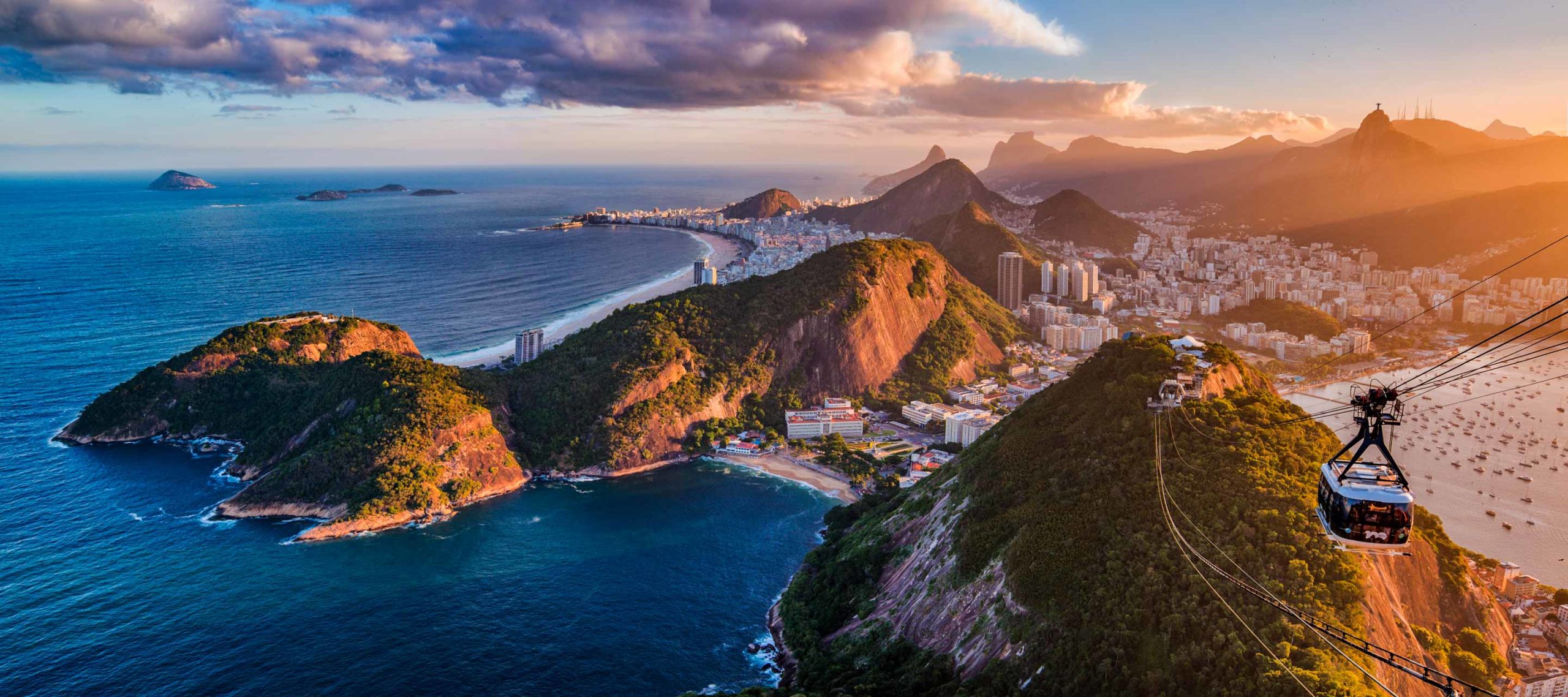

Brazil Overview

Simone Costa
Brazil Local & Expert
Brief History of Brazil
The first inhabitants of Brazil were indigenous people living in tribes near water bodies on the coast and alongside rivers. However, there is not much known about Brazil’s history before the Portuguese arrived in 1500, when Pedro Alvares Cabral, commander of the Portuguese, claimed Brazil.
In 1549, Salvador was founded by the Portuguese as the first capital of Brazil, and it became a significant port for slaves and sugarcane. In the 18th-century, gold was discovered in Brazil and brought in many European immigrants. Minas Gerais became the center of Brazil’s gold mining, where slaves were used in the workforce. In 1888, Brazil abolished slavery after an estimated 4 to 5 million African slaves had been imported.
After the Independence War, Brazil claimed independence from Portugal, and Pedro I ruled until 1831. He then left his son, Emperor Pedro II to rule. In 1889, the First Brazilian Republic was established after a military coup and the ousting of Pedro II. Now, the country’s name was changed to the Republic of the United States of Brazil. In 1967, its name changed again to the Federative Republic of Brazil.


Brazil Politics
Brazil is the Presidential Federated Republic composed of the Union, States, Federal District, and municipalities. Brazil’s current Constitution was promulgated in 1988. The new Constitution replaced the authoritarian legislation that was created by the military regime.
In 1989, Brazil had its first election for a president by direct popular ballot. This was the first election since the 1964 coup. Today, Brazil has a strong democracy. Jair Bolsonaro was elected President of the Republic in the October 2018 race with 57,797,847 votes. He remains the president to this day.
Brazil Economy
Brazil’s economy consists of mining, agriculture, services, and manufacturing. Brazil is a leading producer of minerals, and it exports vast quantities of steel, automobiles, electronics, and consumer goods. In 1720 Brazil discovered coffee and by the mid-1800s, Brazil was responsible for half of the world’s coffee production. From 1880 to 1920, Brazil saw a rubber boom in the Amazon and resulted in Manaus’s village’s transformation into a cosmopolitan center.
Money in Brazil has continued high rates of inflation. In the late 20th century, inflation affected every aspect of Brazil’s economic life. To help combat inflation, the government initiated the Real Plan, a program that strictly limited government spending, introduced a new currency, and made other fiscal reforms.
Regions of Brazil
The Amazon & Northern Brazil
There are 5 regions of Brazil. First, we’ll discuss the Amazon and northern Brazil. Northern Brazil is extremely tropical and covers more than two-fifths of the country. It also features the most considerable portion of the Amazon rainforest. In Brazil’s northern region, you’ll also find parts of the Guiana Shield and the highlands of Brazil.
Northeast Coast of Brazil
In northeastern Brazil, find some of the country’s driest and hottest weather conditions. Here, you’ll discover the island of Fernando de Noronha off the Atlantic coast. This region boasts cities dating back to the 16th-century when sugarcane plantations were active and established. There is a lot of Brazil farm and agricultural production here.
Pantanal & Central Brazil
The Central-West consists of Goiás, Mato Grosso, and Mato Grosso do Sul and the Federal District. The region consists of forested valleys, arid highlands, and lush wetlands. A small part of the nation’s population lives here. Though, over time, a growing number of settlers have been moving into the region and extending its agricultural frontiers.
Southeastern Brazil
The Southeastern region includes São Paulo state, landlocked Minas Gerais, and the populous coastal state of Rio de Janeiro. The city of Rio de Janeiro remains Brazil’s leading cultural and tourist center.
Iguazu & the Southern Coast of Brazil
Southern Brazil includes the states of Paraná, Santa Catarina, and the Rio Grande do Sul. One of the greatest features of southern Brazil is the spectacular Iguazu Falls at the Argentine border. From Curitiba, a beautiful Brazil train journey takes visitors through the Atlantic rainforest to Morretes.




Brazil Environment
In Brazil, the environment consists of seven biomes: the Amazon, the Cerrado, the Caatinga, the Pantanal, the Atlantic Forest, the Pampa – or Southern Fields – and the Coastal.
Iguazu Falls is one of the most breathtaking natural wonders in Brazil. After seeing Iguazu Falls, Elenor Roosevelt said, “it makes our Niagara Falls look like a kitchen faucet.” The mighty Iguazu Falls often end up being the highlight of many trips to Brazil. It’s hard to compete with around 275 waterfalls that span approximately 2 miles in length, falling all at once. To see the Iguazu Falls in their full glory, visit during the rainy season – December to February, this is when there is usually most water passing over the falls.
The Falls are shared between Paraguay, Argentina, and Brazil. A visitor could visit both sides to get the full perspective of Iguazu Falls. On the Brazilian side, you can take a boat ride right up to the base of the waterfalls.
Brazil Wildlife
Sixty percent of the Amazon rainforest is in Brazil, which means there is plenty of wildlife here. Spot hummingbirds, toucans, parrots, macaws, and other bird species. If you’re looking for mammals, you can find the adorable capybaras, sloths, monkeys, pumas, jaguars, armadillos, and pink dolphins here.
In addition to the Amazon, Brazil has an abundance of wildlife at Iguazu Falls. With the water and the humidity, the area around Iguazu is lush and full of wildlife. The biodiversity of the area is worth staying a few days to observe. Bird tours are an immensely popular activity in the Iguazu Falls area. Travelers can spot five different species of toucan. You will also find large mammals such as the jaguar, the lowland tapir, and the capybara.
Brazil Tourist Attractions
According to the World Tourism Organisation (WTO), Brazil is one of the world’s most popular destinations and has some of the best tourist attractions. The country offers tourists plenty of things to do, things to see, and places to visit. From leisure to adventure travel, Brazil has it all.
- Rio de Janeiro: the seaside city famed for its beautiful beaches (Copacabana & Ipanema), and the incredible celebration, Carnival.
- São Paulo: a modern metropolis considered the “New York City” of Brazil.
- Salvador da Bahia: a colonial city known for its Portuguese architecture, Afro-Brazilian culture, and a tropical coastline.
- The Amazon Rainforest: Brazil hosts 60 percent of the Amazon Rainforest.
- Curitiba & the Atlantic Rainforest:
- Lencois Maranhenses: a dazzling display of dunes, white-sand beaches, and crystal clear water.
- Paraty: a well-preserved colonial town (perfect for honeymooners) where the cobblestone streets give way to the ocean.
- Recife & Olinda: known as the “Venice of Brazil!” Recife boasts a beach that is 11 miles long and is famous for its canals, historic town center, and bridges.
- Ilha Grande: an island in Rio de Janeiro state covered by Atlantic rainforest and full of beautiful beaches and perfect snorkeling conditions.
- Ouro Preto: a colonial town known for its baroque architecture, rolling hills, and cobblestone streets.
- Tiradentes: a quaint town full of baroque churches, artisan chocolate shops, art galleries, and more.
- Belo Horizonte: surrounded by mountains and full of Oscar Niemeyer’s architecture, and not far from the incredible Inhotim Museum.
Transportation in Brazil
There are modern metros in both Rio de Janeiro and São Paulo. However, locals mostly use city buses and minivans as a standard way of public transportation. In rural areas, the most common local transport is the motor taxi. Road transport is the most widely used method in Brazil, particularly for goods traded with South American countries.
Brazil Culture
Brazilian culture is something you need to experience. It’s colorful and fun, and it’s one of the main reasons travelers visit the country. One of the best parts of Brazil’s culture is beach life. Beaches are to Brazil what tea is to England! You have probably heard the phrase, “that’s not my cup of tea!” Well, used in the same context, Brazil has a similar saying, “Não é a minha praia”, which translates to “that’s not my beach!”
A major part of Brazil’s culture revolves around enjoying the beach. Take a long walk along the coast, grab a seat, and refresh yourself with a beverage while watching happy locals walk by. Sunbathers, swimmers, and people-watchers all are part of the Brazilian cultural experience. The beaches of Brazil are for the person who loves to watch locals mingle, for those looking to surf, or beaches that take you away to your sunbathing paradise. Rio’s famous Copacabana Beach is a great starting point for any Brazil tour. If you fly directly into the city airport in Rio De Janeiro, Santos Dumont (SDU), you could be on the beach within a couple of hours of landing.
Festivals in Brazil
Another major part of Brazil’s culture is the festivals, particularly Carnival. Samba is the name of the game in Carnival. As a tourist, you can be guided through the celebration with ease. The very name, Carnival translates to “remove meat.” The dates of Carnival change every year because it is a pre-Lent festival. It is derived from the Western religious holiday, Easter. Carnival ends and Lent, a period of sacrifice from food and festivities, in honor of Jesus’s withdrawal into the desert for 40 days.
Carnival is celebrated all over the world but none more famous than the one in Rio De Janeiro. The origin of the music of the Brazilian Carnival started in the Northeastern state of Bahia. That region is considered the cradle of the Afro-Brazilian traditions. After slaves were free, they migrated south, many came to Rio, and that city is now home of Samba. The Brazilian identity is intertwined with Samba. There are over 70 Samba schools in Rio, with the large ones having around 3000 members. Each year the Carnival theme is announced, and the school gets busy creating floats, costumes, writing a theme song, and working out their choreography. The Carnival Parade is a competition!
The competition occurs in Rio’s famous Sambadome – a unique stadium built as a parade ground for Carnival. Rising bleachers are out in the open, looking down on a wide street where the 13 Samba schools parade through their massive drum lines. They compete over a few days, with the competition lasting several hours through the night.
Aside from the main competition, there are street parties all over Rio. Around half a million people come to join in the festivities over the Carnival time. Those street parties are entirely free! If heading to Rio for the big party seems intimidating, there are other parades all over Brazil.
Thinking About Visiting Brazil?
Contact a Brazil Travel Expert
We Love to Talk About Vacation Ideas!
Thinking of traveling to South America? We take your South American travel dream and make it a reality. Every fully custom South America trip is planned by your own expert personal Travel Consultant.


















